CAA News Today
Karen Leader, Author of Chapter 12: Advocacy
posted by CAA — November 15, 2021
As part of CAA’s 10-year anniversary celebration of its publication The Eye, the Hand, the Mind: 100 Years of the College Art Association, chapter authors reflect on their contributions and how their impressions of the field have changed. Our first video in the series features Karen J. Leader, who wrote Chapter 12, “CAA Advocacy: The Nexus of Art and Politics.”
Karen J. Leader is Associate Professor of Art History and Faculty Associate in the Center for Women, Gender and Sexuality Studies at Florida Atlantic University. She received her BA from the University of California, Berkeley and her MA and Ph.D. at the Institute of Fine Arts, New York University. Her areas of interest include art and popular culture in the 19th-21st centuries, feminist theory and practice, and the history and future of the discipline of art history, the humanities, and higher education. She has published on the artist Gustave Courbet, representations of women in popular culture, and 21st-century tattoo culture. She directs the Barb Schmidt Fellowship: Cultivating Community Involvement, Activism and Social Change, and currently chairs the Services to Historians of Visual Arts Committee (SHVAC) at CAA.You can follow her on Instagram and Twitter @proftinkerbell.
CAA Then & Now: Reflections on the Centennial Book and the Next Century
posted by CAA — November 15, 2021
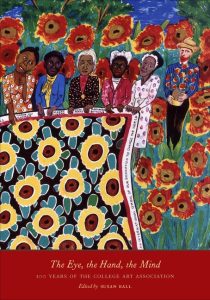
Cover of The Eye, the Hand, the Mind: 100 Years of the College Art Association, edited by Susan Ball (Rutgers, 2011) featuring detail of Faith Ringgold, The Sunflower Quilting Bee at Arles, 1996
On November 4, CAA had the privilege to host the digital event celebrating The Eye, the Hand, the Mind: 100 Years of the College Art Association. If you were unable to make it, please watch this recording of the event.
Published in 2010, this book documents and examines over a century of CAA’s history. The event features Susan Ball, editor of the publication, and author Julia Sienkewicz, who will discuss their contributions to the project and how topics and issues have shifted and changed in the last decade. A conversation between CAA CEO and Executive Director, Meme Omogbai, and art historian, Anne Higonnet, will reflect on these insights and CAA’s plans for the future. This conversation also will honor Robert L. Herbert, the dedicatee of the book, and will discuss how his legacy has impacted the field and so many at CAA.
Following this event, CAA will release a series of short videos from authors discussing their specific chapters within the book, including Julia A. Sienkewicz, Judith Brodsky, Ellen Levy, and Karen Leader. Their presentations will cover a range of topics concerning CAA’s history, from advocacy and feminist initiatives to CAA’s past exhibition programs and conferences.
About the book:
Susan Ball, editor. The Eye, the Hand, the Mind: 100 Years of the College Art Association (Rutgers University Press, 2011). Copies are available for purchase here.
In 1911 the College Art Association began with a small group of college art teachers whose single mission was to promote “art interests in all divisions of American colleges and universities.” One hundred years later the CAA, as it is commonly known, is as diverse as the decades that witnessed its maturity and growth. As leadership and membership grew dynamically, art and art history professors were joined by non-academic visual artists and art historians, museum professionals, art librarians, visual resource curators, independent scholars and artists, collectors, dealers, conservators, and non-college educators.
The Eye, the Hand, the Mind is a collaborative journey, filled with pictorial mementoes and enlivening stories and anecdotes. In these essays readers discover the important role CAA played in major issues in higher education such as curriculum development, preservation of world monuments, workforce issues and market equity, intellectual property and free speech, capturing conflicts and reconciliations inherent among artists and art historians, pedagogical approaches and critical interpretations/interventions as played out in association publications, annual conferences, advocacy efforts, and governance.
Celebrating the centennial of CAA members and milestones, Susan Ball and renowned contributors honor the organization’s complex history which, in part, also represents many learned societies and the humanities over the last one hundred years.
About the speakers:
Susan Ball, Ph.D.: Susan Ball edited The Eye, the Hand, the Mind. Ball holds a Ph.D. in art and architectural history from Yale University and holds over 35 years of professional experience – as a professor, scholar, museum professional and nonprofit agency director. Ball served as Interim Director of Programs at the New York Foundation for the Arts (NYFA). Prior, she was Executive Director at the College Art Association, Professor of Art History at the University of Delaware, the Director of Government and Foundation Affairs at the Art Institute of Chicago, and a consultant with the Shelley and Donald Rubin Foundation. As an author and editor, she has contributed significant works of scholarship in her field, such as The Profitable Artist: A Handbook for All Artists in the Literary, Media, Performing, and Visual Arts with Peter Cobb and Felicity Hogan (Allworth Press, 2011), and has served on many boards.
Julia A. Sienkewicz, PhD: In The Eye, the Hand, the Mind, Sienkewicz authored the chapter, “Uniting the Arts and the Academy: A History of the CAA Annual Conference.” Sienkewicz, an Associate Professor of Art History at Roanoke College, holds both an MA and PhD from the University of Illinois and a BA from Mt. Holyoke College. She is the author of Epic Landscapes: Benjamin Henry Latrobe and the Art of Watercolor (2019). Currently, she is at work on the monograph Forms of White Hegemony: Transnational Sculpture, Racialized Identity, and the Torch of Civilization, 1836-1865, research that has been recognized with the award of a Terra Foundation Fellowship at the American Academy in Rome. She recently edited a special issue of the Art History Pedagogy and Practice journal entitled, “Teaching and Learning the Art History of the United States.” Sienkewicz served in leadership roles at CAA for more than a decade, most recently concluding a term on the Board of Directors as the VP for Committees.
Anne Higonnet, Ph.D.: Anne Higonnet is now Professor of Art History at Barnard College of Columbia University. She received her BA from Harvard College in 1980 and her PhD from Yale University in 1988 under Robert Herbert. Her work has been supported by Getty, Guggenheim, and Social Science Research Council fellowships, as well as by grants from the Mellon, Howard and Kress Foundations. In 2019-2020 she was a Fellow at the Harvard-Radcliffe Institute. She has published many essays, five print books, and two book-scale digital projects, is a prize-winning teacher, and has lectured widely, including in the Live Arts program of the Met Museum. One of her courses, Clothing, is among the most popular at Barnard and Columbia. She is now writing a book under contract with Norton: Three Fashion Stars and the Revolution They Wore; Joséphine Bonaparte, Juliette Récamier, Térésia Tallien.
Meme Omogbai, CAA Executive Director and CEO: Before joining CAA, Omogbai served as a member and past board chair of the New Jersey Historic Trust, one of four landmark entities dedicated to preservation of the state’s historic and cultural heritage, and Montclair State University’s Advisory Board. Named one of 25 Influential Black Women in Business by The Network Journal, Meme has over twenty-five years of experience in corporate, government, higher education, and museum sectors. As the first American of African descent to chair the American Alliance of Museums (AAM), Omogbai led an initiative to rebrand the AAM as a global, inclusive alliance. While COO and trustee, she spearheaded a major transformation in operating performance at the Newark Museum. During her time as deputy assistant chancellor of New Jersey’s Department of Higher Education, Omogbai received legislative acknowledgment and was recognized with the New Jersey Meritorious Service award for her work on college affordability initiatives for families. Omogbai received her MBA from Rutgers University and holds a CPA. She did postgraduate work at Harvard University’s executive management program and has earned the designation of Chartered Global Management Accountant. She studied global museum executive leadership at the J. Paul Getty Trust Museum Leadership Institute, where she also served on the faculty.
ARTexchange Exhibition 2022: Call for Submissions
posted by CAA — November 08, 2021
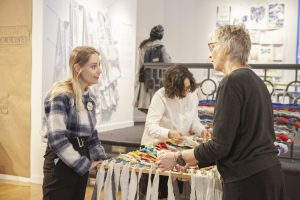
Participants in CAA 2020 ARTexchange. Photo by Stacey Rupolo.
CAA’s Services to Artists Committee seeks proposals for interactive and participatory projects and/or workshops for CAA’s 2022 ARTexchange and ARTexchange Online.
Originally formatted as a pop-up exhibition and meet-up event for artists and curators, ARTexchange provides an opportunity for artists to share their work and build affinities with other artists, historians, curators, and cultural producers.
This year, Columbia College Chicago will host ARTexchange, a dynamic exhibition of participatory projects and/or workshops, in their C33 Gallery. Located on the bustling corner of Ida B. Wells Drive (formerly Congress Parkway) and Wabash Avenue. Artists should be available February 15 or 16 for delivery and installation of their projects, and are highly encouraged to provide engaging and collaborative workshops or interactions with the public on February 17 or 18. The gallery will also be open to the public on Saturday, February 19, and ephemera will remain on exhibition through February 25.
Additionally, ARTexchange will include an online component. The virtual ARTexchange, a day of interactive and participatory projects and/or workshops accessed via Zoom, will take place on Saturday, March 5.
The Services to Artists Committee encourages applications that engage issues of social justice, inclusivity and intersectional discourses in the arts. Proposals that include community engagement and meaningful interaction with CAA and larger communities will be prioritized.
Please email any questions to <a href=”mailto:servicestoartists@gmail.com”>servicestoartists@gmail.com</a>. Include CAA ARTexchange or CAA ARTexchange Online in the subject line.
Apply for the in-person ARTexchange here.
Apply for the virtual ARTexchange Online here.
In Memoriam: Julie L. Green
posted by CAA — November 04, 2021
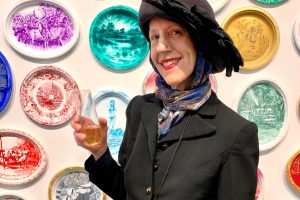
Artist Julie Green in front of one of their pieces in The Armory Show 2020, which included a salon-style presentation of Fashion Plate works, painted on Chinet plates and platters. (Photo by Theo Downes-Le Guin/Upfor Gallery)
Artist and educator Julie Green died at home on Tuesday, October 12, 2021. Green (who preferred gender neutral pronouns) was diagnosed with ovarian cancer nearly two years ago.
Julie Lynn Green was born in 1961 in Yokosuka, Japan to Frederick William (Bill) Green and Jane Green. Green’s birth wasn’t without excitement: their father was airlifted by helicopter off a Navy ship to support Jane during pregnancy complications. Both mother and child were fine. As a child, Green lived in Washington State, Ohio, New Jersey, Illinois, and Iowa, where they attended Des Moines Roosevelt High School, graduating in 1979. From an early age, Green shared their mother’s passion for creative projects, thriving as an artist and performing with a high school mime group. One of Green’s favorite pastimes was to play Scrabble with grandmother “GrandMary.” In 1995, Green married longtime partner Clay Lohmann, who encouraged a lifelong interest in yoga and expanded Green’s artistic pursuits.
Green wrote that they wanted to be a stewardess until age four, but became a painter instead. Green received a B.F.A. and M.F.A. from The University of Kansas, studying with noted artist Roger Shimomura, who remained a lifelong mentor and friend. Green joined the faculty at Oregon State University in Corvallis, Oregon in 2000 as a professor in the Art and Art History Department. While garnering admiration and affection from a generation of students, Green also maintained an active studio practice. Green started their best-known work, a series of paintings on second-hand plates depicting the last meal requests of death row prisoners titled The Last Supper, in 2000. A few weeks before their death, Green decided to end the project at 1,000 plates. The first 800 plates are currently on view at the Bellevue Arts Museum in Bellevue, Washington.
Green worked in a variety of mediums but identified primarily as a painter, often combining humble materials and techniques with art historical traditions. Green painted on linens, Tyvek, and Chinet-brand paper plates as well as paper and canvas, with pigments from sources as diverse as industrial waste byproducts, rare earth elements and 7UP. Awarded a Hallie Ford Fellowship in the Visual Arts from The Ford Family Foundation, Green’s accolades also included grants and fellowships from the Oregon Arts Commission, the ArtPrize 3-D Juried Award, and a Joan Mitchell Foundation Painters and Sculptors Grant. Green’s work was featured in a variety of publications and programs including The New York Times, Rolling Stone, NPR, and PBS, and was exhibited widely in museums and galleries throughout the United States. Green’s final public exhibition in their lifetime, at The Armory Show in New York in 2020, garnered the Presents Award.
Green was preceded in death by their father Frederick WIlliam Green. Green is survived by their husband, artist Clay Lohmann, brother Scott Green, and mother Jane Hamilton.
–Theo Downes-Le Guin and Scott Green
In Conversation: Meme Omogbai speaks with Theresa Avila
posted by CAA — November 01, 2021
We’re delighted to introduce CAA members to a new series of coffee talk conversations between Meme Omogbai, our executive director and CEO, and Theresa Avila, the Program Chair of the 110 Annual Conference. In this first video, they discuss the format of the Conference and how this key program is part of CAA’s response to members, both domestic and international, and vital to positioning our organization for sustainable growth. Upcoming conversations will address questions sent by members. Check it out and send us your thoughts for the next installment!
Please send us your questions: programs@collegeart.org
Speaker Biographies
Theresa Avila is a curator and an Assistant Professor of non-Western Art History at California State University, Channel Islands. She earned a Ph.D. in Art History from the University of New Mexico with a focus on Modern Latin American and Latin@x art. As a scholar and curator her work focuses on the intersections between the visual and political, as she interrogates historiography, empire and nation building, and systems of differentiation. Published works include “Echoing the Call for Revolution: Emiliano Zapata in Chican@x Art” for the exhibition catalogue Emiliano Zapata despues de Zapata (2019), the book Making and Being Made: Contemporary Citizenship, Art, and Visual Culture (2017), as well as the forthcoming “The History of the Barrio Mobile Art Studio, a vehicle for creative transformations” for the fifty-year anthology of Self Help Graphics (2023) and the project “Dialogos: on Landscapes of the Americas” for Latin American and Latinx Visual Culture Journal. (2023). As the Director of the Broome Library Gallery at CSUCI she curated Magnetic Currents: Art charged by the U.S. and Mexico Border (2020); Colecion de Lucha, Desde Santa Paula a las Americas: The Personal Archive of Luzma Espinosa (2019); and Tracing History: Mapping California (2018). Dr. Avila firmly believes we must activate art in meaningful and engage art as a tool for change.
Meme Omogbai, CAA Executive Director and CEO: Before joining CAA, Meme Omogbai served as a member and past board chair of the New Jersey Historic Trust, one of four landmark entities dedicated to preservation of the state’s historic and cultural heritage, and Montclair State University’s Advisory Board. Named one of 25 Influential Black Women in Business by The Network Journal, Meme has over twenty-five years of experience in corporate, government, higher education, and museum sectors. As the first American of African descent to chair the American Alliance of Museums (AAM), Omogbai led an initiative to rebrand the AAM as a global, inclusive alliance. While COO and trustee, she spearheaded a major transformation in operating performance at the Newark Museum. During her time as deputy assistant chancellor of New Jersey’s Department of Higher Education, Omogbai received legislative acknowledgment and was recognized with the New Jersey Meritorious Service award for her work on college affordability initiatives for families. Omogbai received her MBA from Rutgers University and holds a CPA. She did postgraduate work at Harvard University’s executive management program and has earned the designation of Chartered Global Management Accountant. She studied global museum executive leadership at the J. Paul Getty Trust Museum Leadership Institute, where she also served on the faculty.
A letter from CAA’s Executive Director
posted by CAA — October 28, 2021
| Dear CAA members,
Since March of 2020, we have been continually navigating through change—both internally and externally––at CAA. We’ve used this time to gather information from membership and listen to constituencies to position CAA for the future. I am writing to address the matter of a publications restructuring document that was recently shared publicly. The document was created as a preliminary proposal meant for internal discussion following a first-stage period of discovery. The document remains a work in progress. Our next steps in the process will be:
CAA values the voices and expertise of our community and respective constituencies. I will continue to create ongoing opportunities for engagement and dialogue.
Thank you for your continued support. I look forward to providing you with a more detailed monthly report of CAA’s activities in the coming week. In the meantime, please feel free to contact CAA at programs@collegeart.org to share any further comments.  Meme Omogbai
Executive Director and CEO
|
Announcing the CAA 2022 Distinguished Scholar
posted by CAA — October 26, 2021
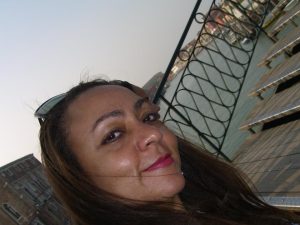
Kirsten Pai Buick
We’re delighted to announce the Distinguished Scholar session at the 110th CAA Annual Conference will honor Kirsten Pai Buick. This session will highlight her career and provide an opportunity for dialogue between and among colleagues. It will be held virtually during the 110th Annual Conference on February 17, 2022.
Established in 2001, the Distinguished Scholar Session illuminates and celebrates the contributions of senior art historians. The Annual Conference Committee identifies the distinguished scholar each year and each session typically brings together the distinguished scholar and a group of colleagues. The honoree’s involvement is fundamental to the series as a way of demonstrating a living tradition that gives voice to the continuities and ruptures that have shaped art-historical scholarship from the twentieth century into the new millennium.
Access to this program requires registration and is included with an All Access registration. Recordings will be accessible to registrants after the event. Register here.
“I identify as a scholar of the visual and material culture of the first British Empire, and the British diaspora in the US, Caribbean, and India. My teaching encompasses topics such as surveys of British Colonial and U.S. Art, American Landscape representation, African American Art, Pro- and Anti-Abolitionist Images in the Atlantic World; and seminars such as Photographing Jim Crow, 1890-1965, Patronizing Women: Taste and Collecting in the 19th and 20th Centuries, and The Victorian Nude: Representing Women, Men, Intersex, and Children. My research and teaching interests encompass histories of science, medicine, religion, as well as monuments, and the use of public space. Increasingly, I am interested in the racialization of mobility—what I characterize as critical mobility studies. I publish primarily in the realm of the history of African American art and its roots in US cultural formations. My first book, “Child of the Fire: Mary Edmonia Lewis and the Problem of Art History’s Black and Indian Subject,” is a good example of how I wed my teaching and publication imperatives together with my challenge to art history and visual studies to be more and to do better. Ultimately, teaching is my passion; and I tell my students that job # 1 is surviving the damage, and job # 2 is to never concede the center.”
Kirsten Pai Buick is a professor of art history at the University of New Mexico. She received her Ph.D. in art history from the University of Michigan and was a SAAM Predoctoral Fellow and a Charles Gaius Bolin Fellow at Williams College. Buick is a recipient of the David C. Driskell Prize for African American Art and has published extensively on African American art, including her book Child of the Fire: Mary Edmonia Lewis and the Problem of Art History’s Black and Indian Subject (Duke Univ. Press, 2010). Her second book, In Authenticity: “Kara Walker” and the Eidetics of Racism, is in progress.
Announcing the CAA 2022 Annual Artists’ Interviews Speakers
posted by CAA — October 26, 2021
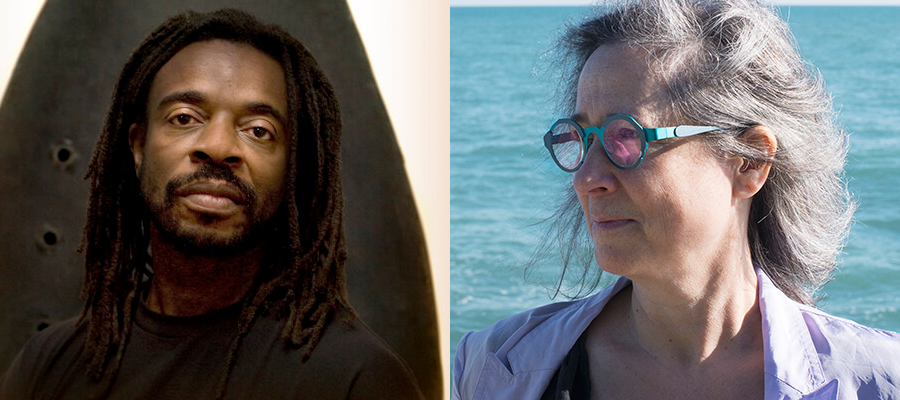
Willie Cole (left) and Jessica Stockholder (right).
We are excited to announce that CAA’s Annual Artists’ Interviews will feature Willie Cole and Jessica Stockholder. Each artist will take part in a one-on-one interview with a colleague during CAA’s 110th Annual Conference. These interviews will take place virtually on February 18, 2022.
Beginning in 1997, the Annual Artists’ Interviews were established to provide the opportunity for esteemed artists to have one-on-one conversations with colleagues at the Annual Conference. Each year, the Services to Artists Committee (SAC) identifies two distinguished artists to participate.
The interviews are held as part of the Services to Artists Program. Access to this program requires registration and is included with an All Access registration, or with stand-alone program registration at no cost. Recordings will be accessible to registrants after the event. Register here.
Speaker Biographies
Willie Cole is a contemporary American sculptor, printer, and perceptual engineer. His work uses contexts of postmodern eclecticism, and combines references and appropriation from African and African American imagery. Cole is best known for his Dada and Surrealist readymades, which assemble and transform ordinary domestic and used objects such as irons, ironing boards, high-heeled shoes, hair dryers, bicycle parts, wooden matches, lawn jockeys, and other discarded appliances and hardware. Cole grew up in Newark, NJ. He attended the Boston University School of Fine Arts, received his Bachelor of Fine Arts degree from the School of Visual Arts in New York in 1976, and continued his studies at the Art Students League of New York from 1976 to 1979.
Recent exhibitions of Cole’s work include To Reclaim, Kavi Gupta, Chicago, IL, USA; New Concepts in Printmaking 2: Willie Cole, MoMA, New York, NY, USA; Reconfiguring an African Icon: Odes to the Mask by Modern and Contemporary Artists from Three Continents, Metropolitan Museum of Art, New York, NY, USA; Chicago, Surrealism: The Conjured Life, Museum of Contemporary Art, Chicago, IL, USA; and Afro: Black Identity in America and Brazil, Tamarind Institute, Albuquerque, NM, USA. Cole’s work is in the permanent collection of the Whitney Museum of American Art, New York, NY; Walker Art Center, Minneapolis, MN; MoMA, New York, NY; National Gallery of Art, Washington, DC; High Museum of Art, Atlanta, GA; Studio Museum in Harlem, NY; Metropolitan Museum of Art, New York, NY; Museum of Contemporary Art, Chicago, IL; Albright-Knox Art Gallery, Buffalo, NY; and many others.
Jessica Stockholder is an internationally acclaimed visual artist and educator who lives and works in Chicago. In addition to earning her BFA from the University of Victoria in Canada and her MFA from Yale University, she was awarded two honorary Doctor of Fine Arts degrees: one from Emily Carr University of Art and Design in 2010, and one from Columbia College in 2013. Stockholder was Elected to the American Academy of Arts & Sciences in 2018.
Stockholder’s works sit at the intersection of painting with sculpture, and often incorporate the architecture in which it has been conceived. Employing a wide range of ordinary everyday materials Stockholder orchestrates an intersection of pictorial and physical space. She probes how meaning derives from physicality, and engages the sensuality and pleasure evoked by color and formal order in an effort to call attention to the edges of understanding.
Stockholder’s work has been exhibited in many of the world’s most influential art venues, including Centre Pompidou in Paris, the Dia Center for the Arts, the Whitney Museum of American Art, and the Venice Biennale. It is included in such museum collections as the Art Institute of Chicago, Whitney Museum of American Art, LACMA, and Stedelijk Museum in Amsterdam.
Stockholder is currently the Raymond W. & Martha Hilpert Gruner Distinguished Service Professor in the Department of Visual Arts at the University of Chicago, a position she accepted in 2011, after 12 years as Director of the Sculpture Department at the Yale School of Art.
Committee on Women in the Arts (CWA) Picks: October
posted by CAA — October 26, 2021
The October Picks from the Committee on Women in the Arts engage with the notion of space and its rich, multi-layered resonances with politics, gender, sexuality, ecology, diaspora and survival. Our selection features exhibitions featuring the work of feminist and womxn artists who respond to current urgencies and stress the importance of thresholds and their liberatory potential in showing these subjects, histories, narratives and discourses which have been invisible and silenced.
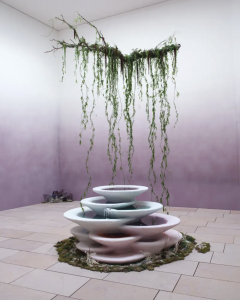
Bianca Bondi, The Daydream, 2021, exhibition view, Fondation Louis Vuitton, Paris.
Sharon Hayes
Ricerche
October 9–November 7, 2021
The Common Guild, Glasgow, United Kingdom
https://www.thecommonguild.org.uk/programme/project/ricerche-6b86
Inspired by Pier Paolo Pasolini’s 1964 film Comizi d’Amore (Love Meetings), Ricerche comprises of several video works presented as ‘ricerche’ or research that navigate intersections between gender, sexuality, politics and contemporary collective identifications in the United States. Hayes’ project with The Common Guild includes three films featuring a range of individuals in which the artist continues her journey of exploration into the entanglements among activism, queerness, love, sexuality and history and their entanglements.
Noémie Goudal
Post Atlantica
October 10, 2021–January 2, 2022
Le Grand Café, Contemporary Art Centre, Saint-Nazaire, France
https://www.grandcafe-saintnazaire.fr/en/expositions/post-atlantica/
Noémie Goudal creates visual stories that via construction of handmade sceneries displaying structural imperfections and playing with perspectives and points of view reveal the process of making an image. Clues that she leaves unveil technical experiments and effects behind constructed scenes that at the first glance do not appear artificial. The exhibition includes works that explore layers of time and space. It features the artist’s new series Post Atlantica, a result of her research into paleoclimatology and her fascination with extreme mutations of landscapes subjected to the force of nature. With this work Goudal invites us to consider, via the image, past and future climate changes.
Frida Orupabo
How did you feel when you come out of the wilderness
September 23–November 21, 2021
Kunsthall Trondheim, Trondheim, Norway
https://kunsthalltrondheim.no/en/utstillinger/frida-orupabo
Frida Orupabo’s art practice reclaims spaces for narratives that are silenced or erased elsewhere. Her physical and digital collages, some of which are featured on her Instagram account @nemiepeba, emphasize the cracks and cuts that need to be sutured with care. Exploring mostly Black visual culture, Orupabo salvages fragments of counternarratives to create a body of knowledge that is rebellious, fugitive and willful. The exhibition presents the artist’s new body of work, including a wallpaper and a wooden sculpture that accompany collages, which engages with survival and the continuous struggle for freedom.
Bianca Bondi
The Daydream
September 22, 2021–January 24, 2022
Fondation Louis Vuitton, Paris, France
https://www.fondationlouisvuitton.fr/en/events/open-space-8-bianca-bondi
Bianca Bondi’s The Daydream transforms Fondation Louis Vuitton’s gallery space into an artificial interior garden offering a multisensorial experience. Inspired by sacred springs, this landscaped place of meditation invites the audience to immerse themselves in reflection and reverie. The artist references rituals and occult practices which connect us to the invisible world. The exhibition features sound designed by Jenn Hutt and flower arrangements designed by Tata Msellati. Olfactive ambience is created by the perfumeur Yann Vasnier. Fostering mutations and transformations between materials, senses and experiences, Bondi’s artistic practice is alchemical, seeking to discover and reveal the intangible.
Eva Davidova
Global Mode > Omnivores
October 5–November 10, 2021
Instituto Cervantes, New York, USA
https://cultura.cervantes.es/nuevayork/en-US/espacios-ocupados-/143561
Global Mode > Omnivores is a solo exhibition of new media artist Eva Davidova. It is part of the Occupied Spaces program inviting multi-faceted collaborations between artists and contexts within which the Instituto Cervantes centres are located. Davidova’s interest in unfixed positions and counterstrategies that disrupt prevailing hierarchies translates into the exhibited single channel video Garden for Drowning Descendants. The work engages with global ecological disaster and interspecies dependency to reflect on the current condition of the world.
Diane Severin Nguyen
IF REVOLUTION IS A SICKNESS
September 16–December 13, 2021
SculptureCenter, Long Island City, NY, USA
https://www.sculpture-center.org/exhibitions/13184/if-revolution-is-a-sickness
Diane Severin Nguyen’s new moving image work commissioned by SculptureCenter and the Renaissance Society at the University of Chicago traces the dichotomous relationship between the East and the West. Set in Warsaw, Poland, the film follows the character of an orphaned Vietnamese child fascinated with K-pop dance culture. The artist navigates the fractures between Eastern Europe and Asia with roots in Cold War allegiances to question inherited cultural divisions and layered conflicts and ways in which these are reckoned while trying to find shared identifications and symbols. The narrative is accompanied by the voice reading excerpts from texts on revolution by Ulrike Meinhof, Hanna Arendt, Mao Zendong among others. The juxtaposition of text and image, and the engagement with contradictory discourses via a photographic and moving image serve to interrogate subject formation and the tensions that emerge from cultural divisions.
Candeğer Furtun
September 16, 2021–April 17, 2022
ARTER, Istanbul, Turkey
https://www.arter.org.tr/en/exhibitions/candegerfurtun
This first retrospective exhibition of Candeğer Furtun’s works, curated by Selen Ansen, explores the notion of the ‘shell’ which often emerges, explicitly and implicitly, in Furtun’s ceramic practice. Featuring over a hundred works, the exhibition presents the artist’s innovative approach to ceramics embodying forms, textures and natural processes that liberate the soil. The notion of the shell manifests the threshold space between the human body and nature which are important in Furtun’s formal and conceptual explorations. It also enables the viewers to interrogate the dynamic transitions between interiority and exteriority, abstraction and figuration, or singularity and plurality.
Affiliated Society News: October
posted by CAA — October 18, 2021
Association of Historians of Nineteenth-Century Art) (AHNCA)
Announcements
AHNCA announces the winners of their Best Paper Prize at their Graduate Symposium. The Eighteenth Annual Graduate Student Symposium in Nineteenth-Century Art, co-sponsored by the Association of Historians of Nineteenth-Century Art (AHNCA) and the Dahesh Museum of Art was held virtually on September 25–26, 2021. Ten participants, representing future directions for nineteenth-century art history, presented their dissertation research. After prolonged deliberation because of the uniform high quality of the presentations, the jury awarded two Dahesh Prizes of $1000 each, funded by the Mervat Zahid Cultural Foundation, to Lieske Huits of the University of Cambridge and the Victoria & Albert Museum, and Sean Kramer of the University of Michigan.

Events
October 20, 2021, 7pm EDT – Upcoming Virtual Salon: The Art Market in the Nineteenth Century
Please join AHNCA on Wednesday, October 20th, at 7PM EDT for their October Virtual Salon on The Art Market in the Nineteenth Century. This series of online events is co-sponsored by the Association of Historians of Nineteenth-Century Art (AHNCA) and the Dahesh Museum of Art.
For this event, AHNCA will host three specialists, Véronique Chagnon-Burke, Anne Helmreich, and Simon Kell, who will discuss this increasingly important area of nineteenth-century studies. Their discussion will be followed by a Q&A and then a break-out room where attendees can socialize informally.
The event is free and open to the public, but registration is required. Register here.
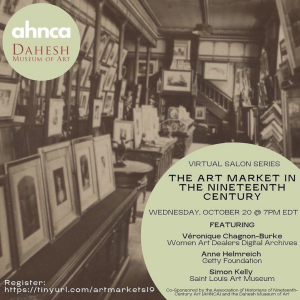
Mid-America College Art Association (MACAA)
Opportunities
Call for art submissions: MACAA Members Virtual Exhibition
MACAA invites its members to submit works of art for consideration to the Members Virtual Exhibition. This exhibition is in coordination with the 2022 Mid-America College Art Association
(MACAA) Virtual Conference, titled “Defining the Undefined: Art, Education, Technology and the Mapping of Ourselves,” hosted by Slippery Rock University of Pennsylvania. The call is open to all mediums and themes. This exhibition, hosted by MACAA via a virtual gallery, is an opportunity to display the incredible work made by MACAA members.
For more information on submission visit this link. Deadline is December 1, 2021.
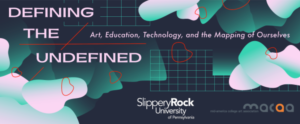
Bibliographical Society of America (BSA)
Events
October 21, 2021, 7pm EDT – Virtual Event: Bluestockings Bookstore: Empowering Queer and Activist Communities
Founded in 1999, Bluestockings Bookstore has served for many years as a cultural hub, activist network, and vibrant community space on the Lower East Side of Manhattan. Entirely all-volunteer run, there are 80+ volunteers, a rotating weekly schedule, and a worker’s collective at the decision-making core. Home to over 300 events a year, Bluestockings offers poetry open-mics, letter writing to prisoners, zine-making workshops, book launches, reading clubs. Panelists Malav Kanuga, Emiliano Lemus, and Joan Dark will share from their personal experiences as former and current members of the Bluestockings collective, offering an in-depth exploration of the space and its pivotal role for queer, transgender, and gender non-conforming individuals.
Register for the event here.

November 1, 2021, 3pm EDT – Collecting, Knowledge, and Power: Perspectives from Latin America
December 9, 2021, 3pm EDT – Collecting and Preserving Colonial Latin America Materials Today: A Roundtable Discussion
The Bibliographic Society of America’s fall series explores the hemispheric histories and contemporary dynamics of collecting and preserving Latin American library and archival materials. Featuring scholars and library and archive professionals based in Latin America and the U.S., the series aims to promote dialogue among scholars and practitioners while confronting ways in which power dynamics have shaped and continue to shape collecting and stewardship practices today.
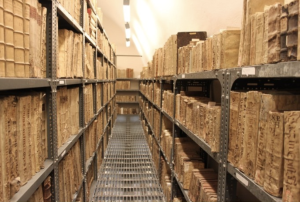
To view past virtual events produced by the Bibliographic Society of America, visit their YouTube page.


